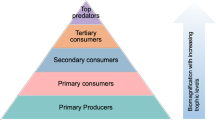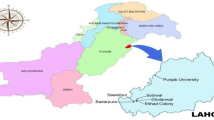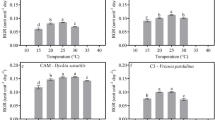Abstract
Responses of growth, photosynthesis and emission of volatile organic compounds of Pinus tabulaeformis exposed to elevated CO2 (700 ppm) and O3 (80 ppb) were studied in open top chambers. Elevated CO2 increased growth, but it did not significantly (p > 0.05) affect net photosynthetic rate, stomatal conductance, chlorophyll content, the maximum quantum yield of photosystem II, or the effective quantum yield of photosystem II electron transport after 90 d of gas exposure. Elevated O3 decreased growth (by 42.2% in needle weight and 25.8% in plant height), net photosynthetic rate and stomatal conductance after 90 d of exposure, but its negative effects were alleviated by elevated CO2. Elevated O3 significantly (p < 0.05) increased the emission rate of volatile organic compounds, which may be a helpful response to protect photosynthetic apparatus against O3 damage.



Similar content being viewed by others
References
Eastburn DM, Degennaro MM, Delucia EH, Dermody O, McElrone AJ (2010) Elevated atmospheric carbon dioxide and ozone alter soybean diseases at SoyFACE. Global Change Biol 16:320–330
Eichelmann H, Oja V, Rasulov B, Padu E, Bichele I, Pettai H, Möls T, Kasparova I, Vapaavuori E, Laisk A (2004) Photosynthetic parameters of birch (Betula pendula Roth) leaves growing in normal and in CO2 and O3 enriched atmospheres. Plant Cell Environ 27:479–495
Hymus GJ, Baker NR, Long SP (2001) Growth in elevated CO2 can both increase and decrease photochemistry and photo inhibition of photosynthesis in a predictable manner. Dactylis glomerata grown in two levels of nitrogen nutrition. Plant Physiol 127:1204–1211
IPCC (2007) Climate change 2007. Working group I report: the physical basis of climate change. http://ipcc-wg1.ucar.edu/wg1/wg1-report.html
Kellomaki S, Wang KY (1997) Effects of elevated O3 and CO2 on chlorophyll fluorescence and gas exchange in Scots pine during the third growing season. Environ Pollut 97:17–27
Kopper BJ, Lindroth RL (2003) Responses of trembling aspen (Populus tremuloides) phytochemistry and aspen blotch leafminer (Phyllonorycter tremuloidiella) performance to elevated levels of atmospheric CO2 and O3. Agr Forest Entomol 5:17–26
Kubiske ME, Quinn VS, Heilman WE, McDonald EP, Marquardt PE, Teclaw RM, Friend AL, Karnosky DF (2006) Interannual climatic variation mediates elevated CO2 and O3 effects on forest growth. Global Change Biol 12(6):1054–1068
Li D, Chen Y, Shi Y, He X, Chen X (2009) Impact of Elevated CO2 and O3 Concentrations on Biogenic Volatile Organic Compounds Emissions from Ginkgo biloba. Bull Environ Contam Toxicol 82:473–477
Liberloo M, Tulva I, Raim O, Kull O, Ceulemans R (2007) Photosynthetic stimulation under long-term CO2 enrichment and fertilization is sustained across a closed Populus canopy profile (EUROFACE). New Phytol 173:537–549
Lichtenthaler HK, Wellburn AR (1983) Determinations of total carotenoids and chlorophylls a and b of leaf extracts in different solvents. Biochem Soc Trans 11:591–592
Loreto F, Velikova V (2001) Isoprene produced by leaves protects the photosynthetic apparatus against ozone damage, quenches ozone products, and reduces lipid peroxidation of cellular membranes. Plant Physiol 127:1781–1787
Loreto F, Pinelli P, Manes F, Kollist H (2004) Impact of ozone on monoterpene emissions and evidence for an isoprene-like antioxidant action of monoterpenes emitted by Quercus ilex leaves. Tree Physiol 24:361–367
Lu T, He X, Chen W (2009) Effects of elevated O3 and CO2 on Pinus tabulaeformis antioxidant system. Chinese J Ecol 28:1316–1323
Manes F, Vitale M, Donato E, Paoletti E (1998) O3 and O3 + CO2 effects on a mediterranean evergreen broadleaf tree. Holm Oak (Quercus ilex L.). Chemosphere 36:801–806
McDonald EP, Kruger EL, Riemenschneider DE, Isebrands JG (2002) The role of competition in modifying growth responses of trembling aspen to elevated CO2 and tropospheric ozone. Funct Ecol 16:792–801
Niewiadomska E, Gaucher VC, Chevrier N, Maufette Y, Dizengremel P (1999) Elevated CO2 does not provide protection against ozone considering activity of several antioxidant enzymes in the leaves of sugar maple. J Plant Physiol 155:70–77
Nikula S, Percy K, Oksanen E, Holopainen T, Manninen S (2009) Effects of elevated ozone on growth and foliar traits of European and hybrid aspen. Boreal Environ Res 14(suppl A):29–47
Riikonen J, Holopainen T, Oksanen E, Vapaavuori E (2005) Leaf photosynthetic characteristics of silver birch during three years of exposure to elevated concentrations of CO2 and O3 in the field. Tree Physiol 25:621–632
Rosenstiel TN, Potosnak MJ, Griffin KL, Fall R, Monson RK (2003) Increased CO2 uncouples growth from isoprene emission in an agriforest ecosystem. Nature 421:256–259
Scarascia-Mugnozza G, Angelis PD, Matteuci G, Valentín R (1996) Long term exposure to elevated CO2 in a natural Quercus ilex L. community: net photosynthesis and photochemical efficiency of PSII at different levels of water stress. Plant Cell Environ 19:643–654
Turnbull MH, Tissue DT, Griffin KL, Rogers GND, Whitehead D (1998) Photosynthetic acclimation to long-term exposure to elevated CO2 concentration in Pinus radiata D. Don. is related to age of needles. Plant Cell Environ 21:1019–1028
Wang L, He X, Chen W (2009) Effects of elevated ozone on photosynthetic CO2 exchange and chlorophyll a fluorescence in leaves of Quercus mongolica grown in urban area. Bull Environ Contam Toxicol 82:478–481
Xia JB, Zhang GC, Zhang SY, Shao HB (2009) Growth process and diameter structure of Pinus tabulaeformis forest for soil and water conservation in the hilly loess region of China. Afr J Biotechnol 8:5415–5421
Yan K, Chen W, He X, Zhang G, Xu S, Wang L (2010) Responses of photosynthesis, lipid peroxidation and antioxidant system in leaves of Quercus mongolica to elevated O3. Environ Exp Bot 69(2):198–204
Zhao X, Mao Z, Xu J (2010) Gas exchange, chlorophyll and growth responses of Betula Platyphylla seedlings to elevated CO2 and nitrogen. Int J Biol 2(1):143–148
Acknowledgments
This study was financially supported by the National Natural Science Foundation of China (31170573) and the Key Project of National Natural Science Foundation of China (90411019), and the National Science and Technology Pillar Program of China (2008BAJ10B04). We thank Prof. Dali Tao for critically reading the manuscript. We also thank all the anonymous reviewers for constructive comments to help improve the manuscript.
Author information
Authors and Affiliations
Corresponding author
Rights and permissions
About this article
Cite this article
Xu, S., Chen, W., Huang, Y. et al. Responses of Growth, Photosynthesis and VOC Emissions of Pinus tabulaeformis Carr. Exposure to Elevated CO2 and/or Elevated O3 in an Urban Area. Bull Environ Contam Toxicol 88, 443–448 (2012). https://doi.org/10.1007/s00128-011-0462-1
Received:
Accepted:
Published:
Issue Date:
DOI: https://doi.org/10.1007/s00128-011-0462-1




